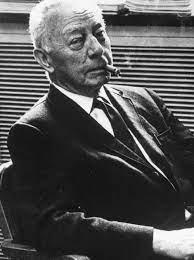 Linus and Ava Helen Pauling in Copenhagen, May 1927
Linus and Ava Helen Pauling in Copenhagen, May 1927[Ed Note: Today and in the three posts that will follow, we will be taking a close look at four important scientific articles published by Linus Pauling between 1927 – 1949.]
In this ambitious and hugely influential paper, Linus Pauling applied his theory of screening constants to various problems, including electric polarizability, diamagnetic susceptibility, and the sizes of ions and atoms. Pauling was fundamentally interested in pursuing this topic because of his desire to merge the new quantum mechanics – which embraced wave functions – with older ideas in order to make predictions about molecular properties like mole refraction and diamagnetic susceptibility in space.
Especially during the early phases of his career, one of Pauling’s signature rhetorical tools was to put forth a bold assumption that would serve to simplify the predictions made later on in a given article. This paper is among the best examples of that approach. In it, Pauling developed mathematical relationships that, when applied, could help the reader make generalizations about molecules. But in moving through these calculations, Pauling had to make some assumptions, oftentimes without the aid of hindsight to determine whether or not they were correct. One enduring legacy of this paper is that many of Pauling’s assumptions were indeed correct, and its findings have thus remained relevant across the decades.
Another contributing factor to the paper’s success was that Pauling was in the right place at the right time. While working towards his PhD at Caltech, Pauling enthusiastically followed the rapid development of quantum mechanics in Europe and elsewhere. Pauling was particularly interested in the work of Arnold Somerfield in Munich and Niels Bohr in Copenhagen, and wrote to both to inquire about research opportunities. Bohr never responded but Sommerfeld did and, with his support, Pauling secured a Guggenheim Fellowship that allowed him to live and work in Europe for 19 months. During that period, he spent most of his time with Sommerfeld at the Institute of Theoretical Physics, though he did visit Bohr in Copenhagen as well as Erwin Schrödinger in Zurich.
Pauling’s residency in Europe proved auspicious, in part because Sommerfeld and his colleagues were working on uniting new ideas with old, a task not being readily pursued in the United States at the time. As they moved forward with their work, the European scientists began to solve more and more problems with quantum mechanics, cementing in Pauling’s mind the utility of the approach as a way forward.
 Gregor Wentzel (Image credit: Emilio Segre Visual Archives)
Gregor Wentzel (Image credit: Emilio Segre Visual Archives)One project important to Pauling’s paper was being led by University of Leipzig physicist Gregor Wentzel. A colleague of Sommerfeld, Wentzel was seeking to apply quantum mechanics to x-rays in order to calculate the screening constants of electrons in large and complex molecules. His project had hit a snag however, in that he was unable to find agreement between the observed data and those predicted by theory. After scrutinizing his work, the young Pauling found that Wentzel had made errors in his calculations. Once Pauling had corrected these miscalculations, he found that there was in fact agreement between the observed and predicted data, which meant that Wentzel’s work was actually correct. In so doing, Pauling had confirmed the value of quantum-mechanical calculations in predicting screening constants of electrons in complex molecules.
Armed with this information, Pauling recognized that he could use these same calculations to make predictions about electron arrangement in molecules and the relative size of ions, among other properties. This led to the publication of his paper, The Theoretical Prediction of the Physical Properties of Many-Electron Atoms and Ions. Mole Refraction, Diamagnetic Susceptibility, and Extension in Space, which appeared in 1927, published by the Proceedings of the Royal Society.
In its essence, the article used the wave mechanical feature of quantum mechanics to make predictions about molecules, an approach that emerged directly from Pauling’s exposure to European efforts to unify old ideas with new. And even though it was not the first time that Pauling had written a paper utilizing quantum mechanics, it was certainly his first publication in which he used these novel tools to make predictions about molecular properties.
Fundamental to these predictions were three key assumptions that Pauling put forth at the beginning of his paper. The first was that,
each electron shell within the atom is idealized as a uniform surface charge of electricity of amount-zi e on a sphere whose radius is equal to the average value of the electron-nucleus distance of the electrons in the shell.
The second assumption stated that,
the motion of the electron under consideration is then determined by the use of the old quantum theory, the azimuthal quantum number being chosen so as to produce the closest approximation of the quantum mechanics.
And the third assumption was that,
since so does not depend on Z, it is evaluated for large values of Z, but expanding powers of zi/Z and neglecting powers higher than the first, and then comparing the expansion with that of the expression containing Z-so in powers of so/Z.
Armed with these assumptions, Pauling was able to issue a collection of predictions about molecules, particularly concerning mole refraction and diamagnetic susceptibility. Prior to his doing so, chemists lacked the necessary tools for making predictions of this sort, meaning that certain chemical properties remained hazy or unknown.
This issue was particularly salient for the hydrogen atom. In the months leading up to the paper’s publication, a huge debate had emerged concerning the polarizability of hydrogen. The prevailing formula had been proven incorrect in 1926, after which time a race ensued to find a new, more suitable equation. Eventually a successor formula was developed, but it was criticized as being “a conservative Newtonian” model. Agreeing that a more robust approach was needed, Pauling set about applying quantum mechanics, and based on his three assumptions, he derived the following:

Knowing full well that the equation was based on his three assumptions, and anticipating resistance, Pauling pre-emptively argued that “it might be thought that these values of ɣ are not correct because of the fact that the electron shells actually do not consist of hydrogen-like electrons, but rather themselves of ‘penetrating electrons.'” However, “as Z [a surface harmonic] increases, the ‘penetrating orbits’ become more hydrogen-like” and therefore should be ignored because any error found would be “negligible.” Having put forth this solution to the problem of hydrogen, Pauling was then able to more broadly demonstrate the utility of his ideas.
Indeed, even though much of the work in the paper made assumptions that were oftentimes crude – such as using data from the valence shell electrons only – Pauling was able to create complex (and, as it turned out, fairly accurate) tables of polarizability of ions, diamagnetism screening constants, and mole refraction, among predictions.
It is clear that Pauling believed strongly in his paper, which he felt would “make possible the accurate prediction of the properties of any atom or ion.” And though the approach would sometimes only yield “approximate values of the physical properties of ions” based on his three assumptions, the importance of the work was not diminished as, oftentimes, directly observed data “may not exist under conditions permitting experimental investigation.”
